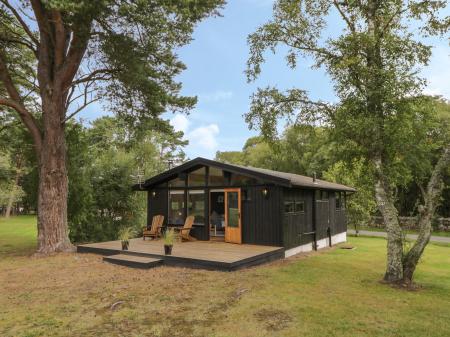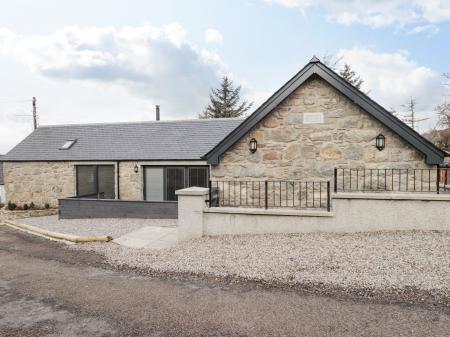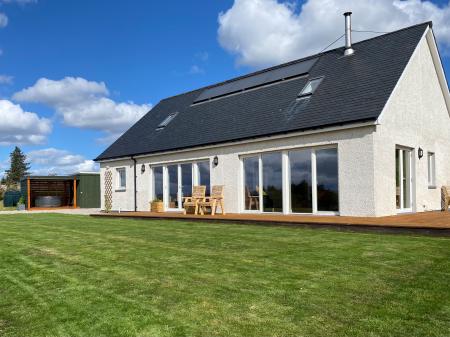
History
The roots of Dunrobin go back to Freskin de Moravia, a Norman who helped both David I and William the Lion regain control of the northern Highlands. Freskin's grandson became Earl of Sutherland in 1235, though the title eventually passed to the Gordon clan.
The earliest parts of the current building date to the 1320s, during the rule of William, the 3rd Earl. In 1401 a stone keep was added to the earlier fortifications. For, make no mistake, Dunrobin was first and foremost a military fortress, as evidenced by the iron yett that defends the entrance.
Most of the medieval defensive features are hidden behind the astonishing French-style chateau created by Sir Charles Barry beginning in 1845. Barry, a master of the Gothic Revival style, was called in to create an example of French elegance on the edge of the North Sea. He succeeded magnificently, creating an ornate fantasy palace decorated with conical turrets.

A Fatal Mistake
One of the most dramatic and ultimately tragic events in Dunrobin's long history dates to the Jacobite Rising under Bonnie Prince Charlie. At the time of the Rising, the Earl of Cromartie was George Mckenzie, a staunch Jacobite.
In April 1746, reports reached the Earl that the Prince's men had been victorious at the Battle of Culloden. Without stopping to verify the truth of the report, Mackenzie gathered his men and launched an attack on Dunrobin Castle, seizing the castle in the name of the Stewart king.
It was only after the Earl's men were ensconced comfortably in Dunrobin that news reached him that Culloden had in fact been a complete and utter disaster for the Jacobite cause. The Sutherland militia quickly surrounded the castle, and the Earl was captured. The apartment where he was found is still known as the Cromartie Room.

The Clearances
It is impossible to talk about Dunrobin without mentioning the Highland Clearances. What is the connection? In 1785 Elizabeth Gordon, Countess of Sutherland, married the wealthy Marquis of Stafford. Armed with her husband's wealth, the Countess set about improving her Highland estates. Part of that 'improvement' involved forcibly clearing crofters from Strathnaver.
The brutal treatment of the residents was headed by Sutherland's factor, a man named Patrick Sellar, who was known to dislike the Gaelic residents. Sellar thought the Gaels were lazy and, perhaps as important to his patroness's interests, they stood in the way of progress. Sellar spearheaded one of the most oppressive and inhumane of the Highland Clearances.
In defence of the Countess, it should be pointed out that she did help new tenant farmers in bringing over 200,000 sheep into Sutherland, and helped build some 450 miles of new roads. Unfortunately, history remembers that Dunrobin Castle was rebuilt in its current form with wealth gained from the grim Clearances of the late 18th and early 19th centuries.

Visiting
We came to Dunrobin on a glorious summer day - something you can't always count on in the Highlands! The castle was shining gleaming white, like some idyllic fantasy castle in a Disney film.
You could not have imagined a more perfectly elegant and impressive sight, with the North Sea gleaming a painful blue beyond the magnificent formal gardens. We saw the interiors in a guided tour, which our entire family - even our 5-year-old - found fascinating.
You really do get a taste for the lifestyle of a bygone age, with hunting trophies on the walls, and family portraits going back centuries. The furniture and art are outstanding. Then we explored the gardens, which are honestly stunning; there are fascinating topiary and formal walks amid colourful flower beds.
One rather intriguing garden feature is an early Greek sacrificial altar, presented to the Duchess of Sutherland in 1910 by Lord Kitchener of Khartoum. Though he had a long and successful military career, Kitchener is probably best remembered for the WWI recruiting poster where he was featured, saying 'Your Country Needs You'!
We were very fortunate to accidentally time our visit to coincide with a hawking demonstration, and our son was able to have a bird of prey land and take off from his shielded wrist. The demonstration was extremely well done and really added to our experience of visiting. I left with a real appreciation for the house, the wonderful gardens, and the history of the castle. I highly recommend Dunrobin; in my eyes, it is one of the great houses of Scotland.







 We've 'tagged' this attraction information to help you find related historic attractions and learn more about major time periods mentioned.
We've 'tagged' this attraction information to help you find related historic attractions and learn more about major time periods mentioned.


